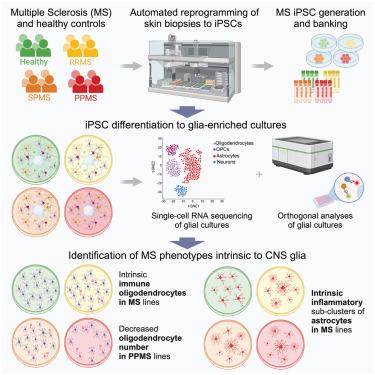当前位置:
X-MOL 学术
›
Cell Stem Cell
›
论文详情
Our official English website, www.x-mol.net, welcomes your
feedback! (Note: you will need to create a separate account there.)
Patient iPSC models reveal glia-intrinsic phenotypes in multiple sclerosis
Cell Stem Cell ( IF 19.8 ) Pub Date : 2024-08-26 , DOI: 10.1016/j.stem.2024.08.002 Benjamin L L Clayton 1 , Lilianne Barbar 2 , Maria Sapar 2 , Kriti Kalpana 2 , Chandrika Rao 2 , Bianca Migliori 2 , Tomasz Rusielewicz 2 , 2 , Daniel Paull 2 , Katie Brenner 2 , Dorota Moroziewicz 2 , Ilana Katz Sand 3 , Patrizia Casaccia 4 , Paul J Tesar 1 , Valentina Fossati 2
Cell Stem Cell ( IF 19.8 ) Pub Date : 2024-08-26 , DOI: 10.1016/j.stem.2024.08.002 Benjamin L L Clayton 1 , Lilianne Barbar 2 , Maria Sapar 2 , Kriti Kalpana 2 , Chandrika Rao 2 , Bianca Migliori 2 , Tomasz Rusielewicz 2 , 2 , Daniel Paull 2 , Katie Brenner 2 , Dorota Moroziewicz 2 , Ilana Katz Sand 3 , Patrizia Casaccia 4 , Paul J Tesar 1 , Valentina Fossati 2
Affiliation

|
Multiple sclerosis (MS) is an inflammatory and neurodegenerative disease of the central nervous system (CNS), resulting in neurological disability that worsens over time. While progress has been made in defining the immune system’s role in MS pathophysiology, the contribution of intrinsic CNS cell dysfunction remains unclear. Here, we generated a collection of induced pluripotent stem cell (iPSC) lines from people with MS spanning diverse clinical subtypes and differentiated them into glia-enriched cultures. Using single-cell transcriptomic profiling and orthogonal analyses, we observed several distinguishing characteristics of MS cultures pointing to glia-intrinsic disease mechanisms. We found that primary progressive MS-derived cultures contained fewer oligodendrocytes. Moreover, MS-derived oligodendrocyte lineage cells and astrocytes showed increased expression of immune and inflammatory genes, matching those of glia from MS postmortem brains. Thus, iPSC-derived MS models provide a unique platform for dissecting glial contributions to disease phenotypes independent of the peripheral immune system and identify potential glia-specific targets for therapeutic intervention.
中文翻译:

患者 iPSC 模型揭示了多发性硬化症中的神经胶质细胞内在表型
多发性硬化症 (MS) 是一种中枢神经系统 (CNS) 的炎症和神经退行性疾病,会导致神经功能障碍随着时间的推移而恶化。虽然在确定免疫系统在 MS 病理生理学中的作用方面取得了进展,但内在 CNS 细胞功能障碍的贡献仍不清楚。在这里,我们从 MS 患者中生成了一系列跨越不同临床亚型的诱导多能干细胞 (iPSC) 细胞系,并将它们分化为富含神经胶质细胞的培养物。使用单细胞转录组学分析和正交分析,我们观察到 MS 培养物的几个显着特征,这些特征指向神经胶质细胞内在疾病机制。我们发现原代进行性 MS 衍生的培养物含有较少的少突胶质细胞。此外,MS 衍生的少突胶质细胞谱系细胞和星形胶质细胞显示免疫和炎症基因的表达增加,与 MS 死后脑胶质细胞的表达相匹配。因此,iPSC 衍生的 MS 模型提供了一个独特的平台,用于剖析神经胶质细胞对独立于外周免疫系统的疾病表型的影响,并确定治疗干预的潜在神经胶质细胞特异性靶点。
更新日期:2024-08-26
中文翻译:

患者 iPSC 模型揭示了多发性硬化症中的神经胶质细胞内在表型
多发性硬化症 (MS) 是一种中枢神经系统 (CNS) 的炎症和神经退行性疾病,会导致神经功能障碍随着时间的推移而恶化。虽然在确定免疫系统在 MS 病理生理学中的作用方面取得了进展,但内在 CNS 细胞功能障碍的贡献仍不清楚。在这里,我们从 MS 患者中生成了一系列跨越不同临床亚型的诱导多能干细胞 (iPSC) 细胞系,并将它们分化为富含神经胶质细胞的培养物。使用单细胞转录组学分析和正交分析,我们观察到 MS 培养物的几个显着特征,这些特征指向神经胶质细胞内在疾病机制。我们发现原代进行性 MS 衍生的培养物含有较少的少突胶质细胞。此外,MS 衍生的少突胶质细胞谱系细胞和星形胶质细胞显示免疫和炎症基因的表达增加,与 MS 死后脑胶质细胞的表达相匹配。因此,iPSC 衍生的 MS 模型提供了一个独特的平台,用于剖析神经胶质细胞对独立于外周免疫系统的疾病表型的影响,并确定治疗干预的潜在神经胶质细胞特异性靶点。

































 京公网安备 11010802027423号
京公网安备 11010802027423号